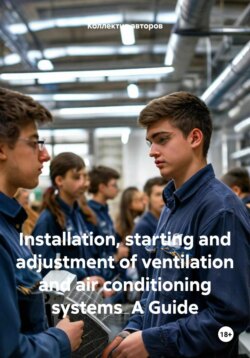Читать книгу Installation, starting and adjustment of ventilation and air conditioning systems A Guide - - Страница 10
Chapter III. Equipment of air ventilation systems
3.4. Supply installations
ОглавлениеThe supply units (Fig.5) filter fresh air, if necessary, heat it (in the cold season) and supply it to the duct system for subsequent distribution around the premises.
Fig.5. The supply unit
Inlet ventilation units consist of a housing in which are mounted: filter, water or electric heater, fan, automation system, sound insulation material,
Conditionally, Inlet installations can be divided into several types:
by type of heater (with an electric heater or with a water heater), by air consumption (up to 200–3000 m3/h – mini-supply installations, more than 3000 m3/h – central supply installations), by design (for vertical installation, for horizontal mounting, universal)
The automatic control system of the supply unit allows you to gradually or smoothly adjust the thermal power of the electric heater. If a water heater is used in the supply unit, then the automation has a more complex design, since in this case it is necessary to provide additional protection against freezing of the heater in winter.
In ventilation systems with supply installations, the following additional elements can be used: air intake grilles, a valve for supply air (with an electric drive or manual drive), mufflers, devices for adjusting air flow in rooms, air distribution devices (diffusers, grilles, plafonds).
Structurally, the chambers are a monoblock structure and can be equipped with automatic control of various levels of complexity from simple functions such as START, STOP, OPEN-CLOSE VALVE, to programmable control of parameters (room temperature, performance, temperature inside the chamber, etc.) along a continuous circuit.
The supply chamber includes the following elements:
A double-sided suction fan, which is attached to the frame traverses through rubber vibration isolators. The frame is made of aluminum profiles and connecting corners.
Insulated panels made of galvanized steel on the outside and inside. Foam insulation is laid in the panel as a heater and sound insulator. For tightness, a self-adhesive sealer is laid between the panels and the frame. On one side of the camera, for ease of maintenance, the panels are made quick-detachable, for which they are equipped with rotary clamps.
Heater (water heater or electric heating elements).
Soft insert made of rubberized fabric with flanges on both sides. The flanges are made of a galvanized tire connected by corners.
Quick-release air filter.
Insulated air valve with electric drive.
To create a balance of the incoming and outgoing air from the room, exhaust ventilation is used, which can be represented by:
• autonomous axial fans installed directly in the wall;
• roof fans installed on the roof;
• centrifugal fans mounted on brackets in the wall or on metal roof structures;
• duct fans in a shell-shaped housing or in a box-shaped housing installed in a network of air ducts (have a nozzle at the inlet and a diffuser at the outlet, and in the case of installing a two-way suction fan – two at the inlet and one at the outlet).
• exhaust ventilation units equipped with fans, flexible inserts, control valves and assembled in a single housing (Fig. 6).
Fig.6 Exhaust system
Supply and exhaust ventilation systems can significantly reduce heating costs by using heat recovery. The heat removed from the room air can be used to heat the supply air in special heat exchangers called recuperators.
Such a system, using a cross-flow recuperator and made in the form of a monoblock, is characterized by a high efficiency of heat recovery, reaching 70%, and provides at least a twofold reduction in operating costs for air heating due to heat recovery (Fig.7).
Fig.7. Supply and exhaust system with recovery
Heat recovery units are designed for the organization of supply and exhaust ventilation in comfortable air conditioning systems, i.e. they change the temperature and humidity of incoming fresh air taking into account the climatic conditions inside the serviced room.
The cross-flow plate regenerative heat exchanger is made of a heat-conducting material having the property of selective permeability with respect to water molecules (practically the membrane is impermeable with respect to molecules of other gases and substances). Due to this, the difference in the partial pressures of water vapor in the outdoor and exhaust air leads to the transfer of moisture from one stream to another. In the cold season, water molecules from the wetter exhaust air penetrate through the membrane into the outside air stream, humidifying it. In the warm season, water molecules from the wetter outdoor air penetrate into the exhaust air stream, preventing excessive humidification of the room.
